Avoid losing your account via fake "Chase - Account Verification" emails
Phishing/ScamAlso Known As: "Chase - Account Verification" phishing email
Get free scan and check if your device is infected.
Remove it nowTo use full-featured product, you have to purchase a license for Combo Cleaner. Seven days free trial available. Combo Cleaner is owned and operated by RCS LT, the parent company of PCRisk.com.
What kind of email is "Chase - Account Verification"?
Our inspection of this "Chase - Account Verification" email revealed that it is fake. The purpose of this spam mail is to deceive recipients into disclosing their online bank log-in credentials to a phishing website by making false claims regarding suspicious activities occurring on their accounts.
Victims of this email risk having their online banking accounts stolen. It must be emphasized that this scam mail is in no way associated with the actual JPMorgan Chase Bank.
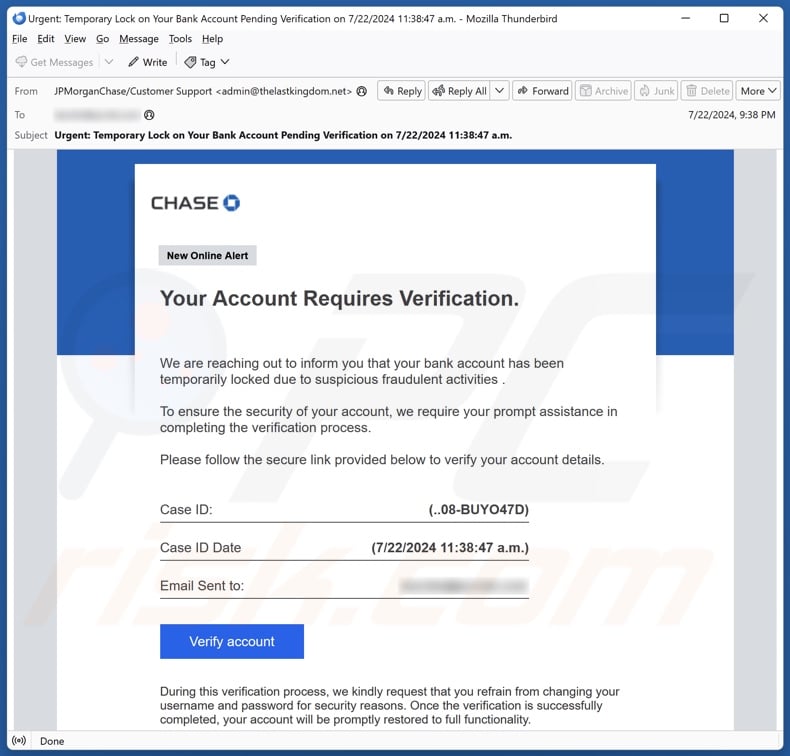
"Chase - Account Verification" email scam overview
This spam email is presented as an alert from Chase Bank. This bogus message reports "suspicious fraudulent activities" detected on the recipient's Chase account.
Due to this supposed activity, the bank account has been suspended. The recipient is requested to complete a verification process to secure their account. Additionally, the email warns against changing the account's log-in credentials (username/password).
It must be stressed that all the information provided by this message is false. And it has to be reiterated that this email is not associated with the real JPMorgan Chase Bank.
This scam letter promotes a phishing webpage hosted on a hacked site. It is disguised as the Chase sign-in page. Attempts to sign in through this website – expose the log-in credentials to scammers, thereby enabling them to steal the banking accounts.
Cyber criminals may then use the compromised accounts to facilitate fraudulent transactions, make online purchases, or carry out other nefarious activities.
To summarize, victims of scam mail like "Chase - Account Verification" may experience severe privacy issues, financial losses, and even identity theft.
If you have already entered your log-in credentials into a phishing website/file – immediately change the passwords of all potentially exposed accounts and inform their official support. It may also be necessary to contact the appropriate authorities.
| Name | "Chase - Account Verification" phishing email |
| Threat Type | Phishing, Scam, Social Engineering, Fraud |
| Fake Claim | Suspicious activity was detected on the user's online bank account. |
| Disguise | Chase Bank |
| Related Domains | techmaaxx[.]com, cd07-logs[.]de |
| Detection Names (techmaaxx[.]com) | N/A (VirusTotal) |
| Serving IP Address (techmaaxx[.]com) | 68.235.35.187 |
| Symptoms | Unauthorized online purchases, changed online account passwords, identity theft, illegal access of the computer. |
| Distribution methods | Deceptive emails, rogue online pop-up ads, search engine poisoning techniques, misspelled domains. |
| Damage | Loss of sensitive private information, monetary loss, identity theft. |
| Malware Removal (Windows) |
To eliminate possible malware infections, scan your computer with legitimate antivirus software. Our security researchers recommend using Combo Cleaner. Download Combo CleanerTo use full-featured product, you have to purchase a license for Combo Cleaner. 7 days free trial available. Combo Cleaner is owned and operated by RCS LT, the parent company of PCRisk.com. |
Phishing spam campaign examples
"International Human Rights Organisation Compensation", "OUTFRONT Email Quarantine", "DHL Delivery Interrupted", and "British Columbia Lottery" are just some of our newest articles on phishing campaigns. These emails primarily target log-in credentials, personally identifiable information, and finance-related data.
While the widely held belief that spam mail is full of grammatical/spelling errors and other mistakes is not untrue, it is not always the case. These emails can be competently crafted and even believably disguised as messages from legitimate entities (e.g., service providers, companies, organizations, authorities, etc.).
How do spam campaigns infect computers?
Spam campaigns are commonly used in malware distribution. Deceptive emails/messages can have infectious files attached to or linked inside them. These files can be documents (PDF, Microsoft Office, Microsoft OneNote, etc.), executables (.exe, run, etc.), archives (ZIP, RAR, etc.), JavaScript, and so forth.
Merely opening such a file can be enough to trigger the malware download/installation chain. However, some formats require additional user interaction to jumpstart infection processes. For example, Microsoft Office documents require users to enable macro commands (i.e., editing/content), while OneNote files need them to click embedded content (e.g., links, files, etc.).
How to avoid installation of malware?
We strongly recommend exercising caution with incoming emails, DMs/PMs, SMSes, and other messages. Attachments or links in dubious/irrelevant mail must not be opened, as they can be malicious.
It must be mentioned that malware is not spread exclusively via spam mail. Therefore, we advise vigilance while browsing since the Internet is rife with deceptive and dangerous content.
Furthermore, all downloads must be made from official and verified channels. Another recommendation is to activate and update programs using genuine functions/tools, as illegal activation ("cracking") tools and third-party updaters can contain malware.
It is paramount for device/user safety to have a reputable anti-virus installed and kept updated. Security software must be used to perform regular system scans and to remove detected threats and issues. If you've already opened malicious attachments, we recommend running a scan with Combo Cleaner Antivirus for Windows to automatically eliminate infiltrated malware.
Text presented in the "Chase - Account Verification" spam email letter:
Subject: Urgent: Temporary Lock on Your Bank Account Pending Verification on 7/22/2024 11:38:47 a.m.
Chase
New Online Alert
Your Account Requires Verification.
We are reaching out to inform you that your bank account has been temporarily locked due to suspicious fraudulent activities .
To ensure the security of your account, we require your prompt assistance in completing the verification process.
Please follow the secure link provided below to verify your account details.
Case ID: (..08-BUYO47D)
Case ID Date (7/22/2024 11:38:47 a.m.)
Email Sent to: -
Verify account
During this verification process, we kindly request that you refrain from changing your username and password for security reasons. Once the verification is successfully completed, your account will be promptly restored to full functionality.
Screenshot of the fake Chase website promoted by this spam campaign:
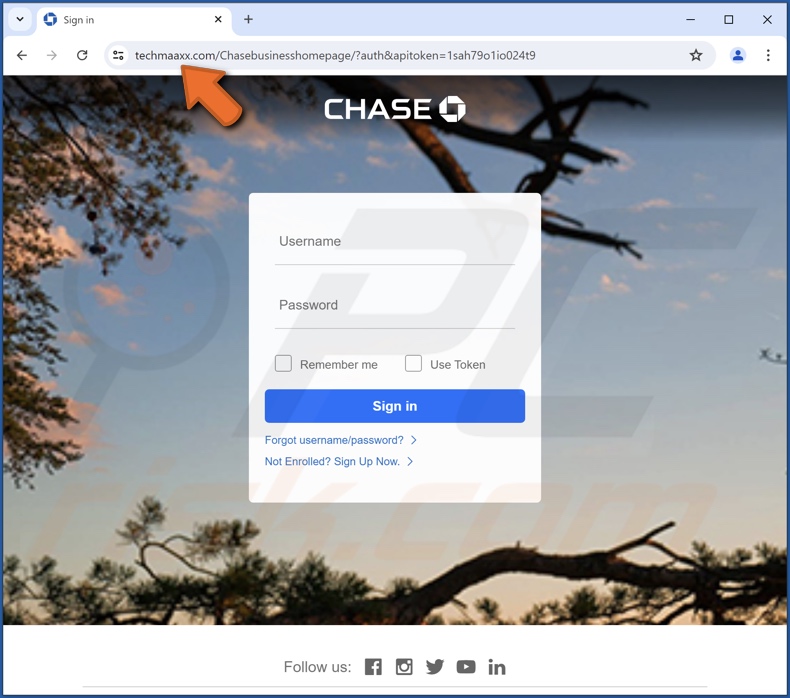
Other examples of emails from "Chase - Account Verification" spam campaign:
Sample 1:
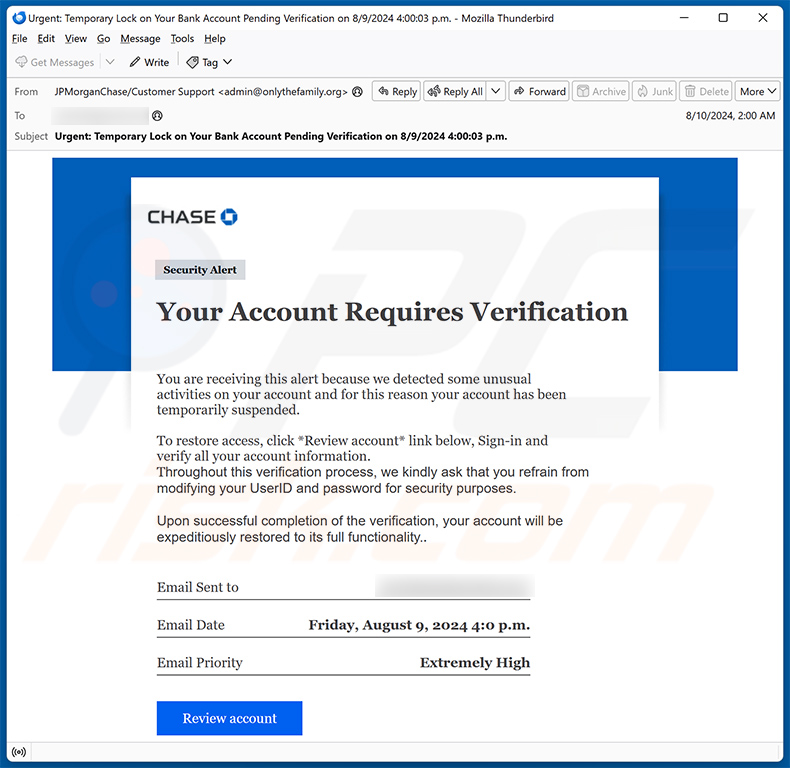
Text presented within:
Subject: Urgent: Temporary Lock on Your Bank Account Pending Verification on 8/9/2024 4:00:03 p.m.
Chase
Security Alert
Your Account Requires VerificationYou are receiving this alert because we detected some unusual
activities on your account and for this reason your account has been
temporarily suspended.To restore access, click *Review account* link below, Sign-in and
verify all your account information.
Throughout this verification process, we kindly ask that you refrain from modifying your UserID and password for security purposes.Upon successful completion of the verification, your account will be expeditiously restored to its full functionality..
Email Sent to ********
Email Date Friday, August 9, 2024 4:0 p.m.
Email Priority Extremely High
Review account
Securely access your accounts with the Chase Mobile® app or chase.com.
Sample 2:
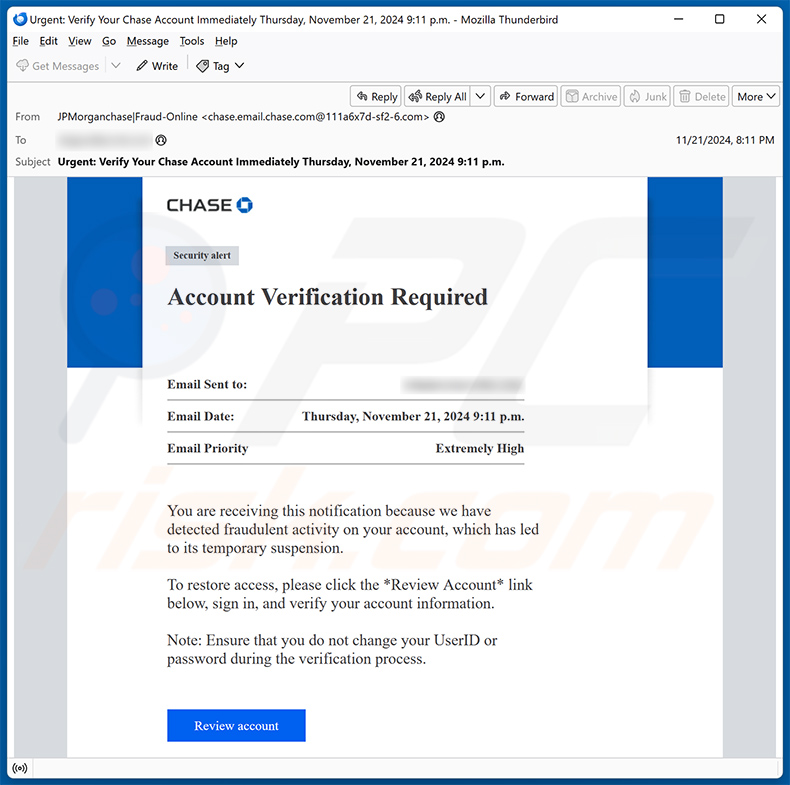
Text presented within:
Subject: Urgent: Verify Your Chase Account Immediately Thursday, November 21, 2024 9:11 p.m.
Chase
Security alert
Account Verification Required
Email Sent to: (********)
Email Date: Thursday, November 21, 2024 9:11 p.m.
Email Priority Extremely High
You are receiving this notification because we have detected fraudulent activity on your account, which has led to its temporary suspension.To restore access, please click the *Review Account* link below, sign in, and verify your account information.
Note: Ensure that you do not change your UserID or password during the verification process.
Review account
Securely access your accounts with the Chase Mobile® app or chase.com.GDF
Sample 3:
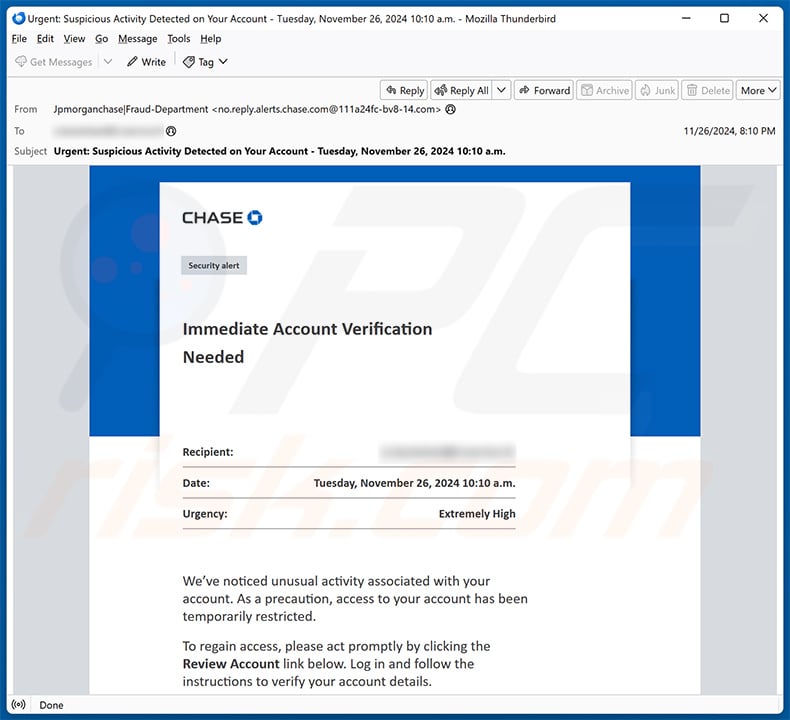
Text presented within:
Subject: Urgent: Suspicious Activity Detected on Your Account - Tuesday, November 26, 2024 10:10 a.m.
Chase
Security alertImmediate Account Verification Needed
Recipient: (********)
Date: Tuesday, November 26, 2024 10:10 a.m.
Urgency: Extremely HighWe’ve noticed unusual activity associated with your account. As a precaution, access to your account has been temporarily restricted.
To regain access, please act promptly by clicking the Review Account link below. Log in and follow the instructions to verify your account details.
Important: For your protection, avoid updating your UserID or password during this process.
Thank you for addressing this matter quickly.
Review Account
Securely access your accounts with the Chase Mobile® app or chase.com.
Sample 4:
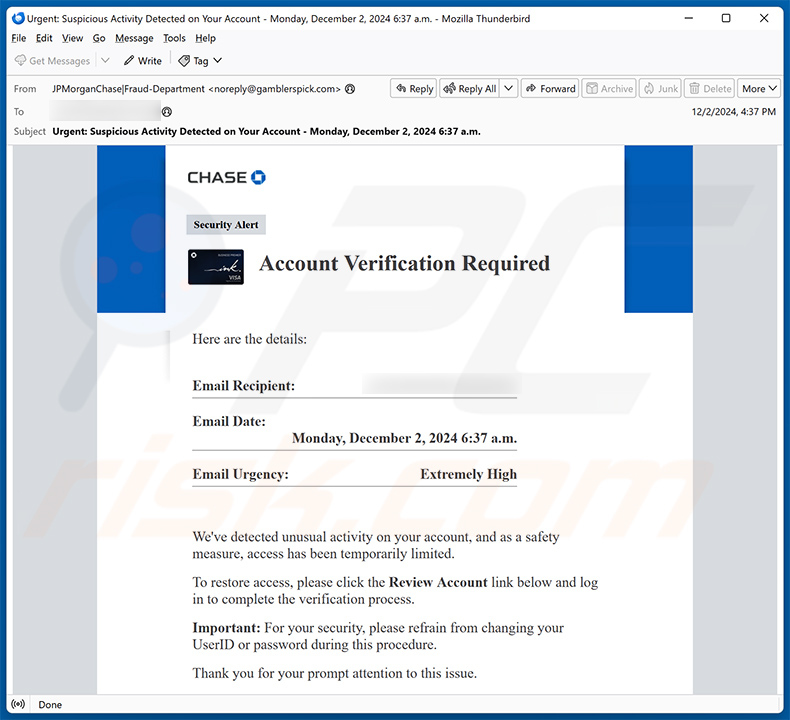
Text presented within:
Subject: Urgent: Suspicious Activity Detected on Your Account - Monday, December 2, 2024 6:37 a.m.
Chase
Security Alert
Account Verification RequiredHere are the details:
Email Recipient: -
Email Date:
Monday, December 2, 2024 6:37 a.m.
Email Urgency: Extremely HighWe've detected unusual activity on your account, and as a safety measure, access has been temporarily limited.
To restore access, please click the Review Account link below and log in to complete the verification process.
Important: For your security, please refrain from changing your UserID or password during this procedure.
Thank you for your prompt attention to this issue.
Review account
Securely access your accounts with the Chase Mobile® app or chase.com.
Sample 5:
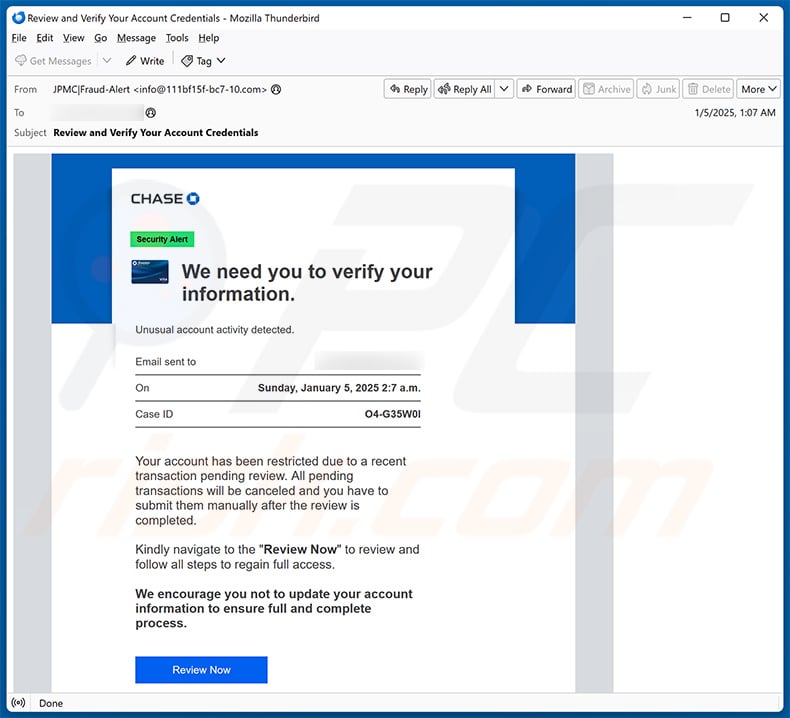
Text presented within:
Subject: Review and Verify Your Account Credentials
Chase
Security Alert
We need you to verify your information.Unusual account activity detected.
Email sent to ********
On Sunday, January 5, 2025 2:7 a.m.
Case ID O4-G35W0I
Your account has been restricted due to a recent transaction pending review. All pending transactions will be canceled and you have to submit them manually after the review is completed.Kindly navigate to the "Review Now" to review and follow all steps to regain full access.
We encourage you not to update your account information to ensure full and complete process.
Review Now
Securely access your accounts with the Chase Mobile® app or chase.com.
ABOUT THIS MESSAGEChase Mobile® app is available for select mobile devices. Message and data rates may apply.
This service email was sent based on your alert settings. Use the Chase Mobile app or visit chase.com/alerts to view or manage your settings.
Your privacy is important to us. See our online Security Center to learn how to protect your information.
© 2023 JPMorgan Chase & Co.
Instant automatic malware removal:
Manual threat removal might be a lengthy and complicated process that requires advanced IT skills. Combo Cleaner is a professional automatic malware removal tool that is recommended to get rid of malware. Download it by clicking the button below:
DOWNLOAD Combo CleanerBy downloading any software listed on this website you agree to our Privacy Policy and Terms of Use. To use full-featured product, you have to purchase a license for Combo Cleaner. 7 days free trial available. Combo Cleaner is owned and operated by RCS LT, the parent company of PCRisk.com.
Quick menu:
- What is "Chase - Account Verification" phishing email?
- Types of malicious emails.
- How to spot a malicious email?
- What to do if you fell for an email scam?
Types of malicious emails:
![]() Phishing Emails
Phishing Emails
Most commonly, cybercriminals use deceptive emails to trick Internet users into giving away their sensitive private information, for example, login information for various online services, email accounts, or online banking information.
Such attacks are called phishing. In a phishing attack, cybercriminals usually send an email message with some popular service logo (for example, Microsoft, DHL, Amazon, Netflix), create urgency (wrong shipping address, expired password, etc.), and place a link which they hope their potential victims will click on.
After clicking the link presented in such email message, victims are redirected to a fake website that looks identical or extremely similar to the original one. Victims are then asked to enter their password, credit card details, or some other information that gets stolen by cybercriminals.
![]() Emails with Malicious Attachments
Emails with Malicious Attachments
Another popular attack vector is email spam with malicious attachments that infect users' computers with malware. Malicious attachments usually carry trojans that are capable of stealing passwords, banking information, and other sensitive information.
In such attacks, cybercriminals' main goal is to trick their potential victims into opening an infected email attachment. To achieve this goal, email messages usually talk about recently received invoices, faxes, or voice messages.
If a potential victim falls for the lure and opens the attachment, their computers get infected, and cybercriminals can collect a lot of sensitive information.
While it's a more complicated method to steal personal information (spam filters and antivirus programs usually detect such attempts), if successful, cybercriminals can get a much wider array of data and can collect information for a long period of time.
![]() Sextortion Emails
Sextortion Emails
This is a type of phishing. In this case, users receive an email claiming that a cybercriminal could access the webcam of the potential victim and has a video recording of one's masturbation.
To get rid of the video, victims are asked to pay a ransom (usually using Bitcoin or another cryptocurrency). Nevertheless, all of these claims are false - users who receive such emails should ignore and delete them.
How to spot a malicious email?
While cyber criminals try to make their lure emails look trustworthy, here are some things that you should look for when trying to spot a phishing email:
- Check the sender's ("from") email address: Hover your mouse over the "from" address and check if it's legitimate. For example, if you received an email from Microsoft, be sure to check if the email address is @microsoft.com and not something suspicious like @m1crosoft.com, @microsfot.com, @account-security-noreply.com, etc.
- Check for generic greetings: If the greeting in the email is "Dear user", "Dear @youremail.com", "Dear valued customer", this should raise suspiciousness. Most commonly, companies call you by your name. Lack of this information could signal a phishing attempt.
- Check the links in the email: Hover your mouse over the link presented in the email, if the link that appears seems suspicious, don't click it. For example, if you received an email from Microsoft and the link in the email shows that it will go to firebasestorage.googleapis.com/v0... you shouldn't trust it. It's best not to click any links in the emails but to visit the company website that sent you the email in the first place.
- Don't blindly trust email attachments: Most commonly, legitimate companies will ask you to log in to their website and to view any documents there; if you received an email with an attachment, it's a good idea to scan it with an antivirus application. Infected email attachments are a common attack vector used by cybercriminals.
To minimise the risk of opening phishing and malicious emails we recommend using Combo Cleaner Antivirus for Windows.
Example of a spam email:

What to do if you fell for an email scam?
- If you clicked on a link in a phishing email and entered your password - be sure to change your password as soon as possible. Usually, cybercriminals collect stolen credentials and then sell them to other groups that use them for malicious purposes. If you change your password in a timely manner, there's a chance that criminals won't have enough time to do any damage.
- If you entered your credit card information - contact your bank as soon as possible and explain the situation. There's a good chance that you will need to cancel your compromised credit card and get a new one.
- If you see any signs of identity theft - you should immediately contact the Federal Trade Commission. This institution will collect information about your situation and create a personal recovery plan.
- If you opened a malicious attachment - your computer is probably infected, you should scan it with a reputable antivirus application. For this purpose, we recommend using Combo Cleaner Antivirus for Windows.
- Help other Internet users - report phishing emails to Anti-Phishing Working Group, FBI’s Internet Crime Complaint Center, National Fraud Information Center and U.S. Department of Justice.
Frequently Asked Questions (FAQ)
Why did I receive this email?
Spam emails are not personal, even if they include details relevant to the recipients. Cyber criminals distribute this mail in large-scale operations – therefore, thousands of users receive identical or incredibly similar emails.
I have provided my personal information when tricked by this spam email, what should I do?
If you have disclosed your account credentials – change the passwords of all potentially compromised accounts and inform their official support without delay. And if you've provided other private data (e.g., ID card details, passport scans/photos, credit card numbers, etc.) – immediately contact relevant authorities.
I have read a spam email but didn't open the attachment, is my computer infected?
Opening/Reading an email is harmless; devices are infected when malicious attachments or links are opened/clicked.
I have downloaded and opened a file attached to a spam email, is my computer infected?
What are your device was compromised might depend on the format of the opened file. Executables (.exe, .run, etc.) cause infections almost without fail once opened. However, other formats – like documents (.doc, .xls, .one, .pdf, etc.) – may need extra actions to begin downloading/installing malware (e.g., enabling macros, clicking embedded content, etc.).
Will Combo Cleaner remove malware infections present in email attachments?
Yes, Combo Cleaner is capable of detecting and eliminating most of the known malware infections. Remember that high-end malware usually hides deep within systems – therefore, performing a complete system scan is essential for detection.
Share:

Tomas Meskauskas
Expert security researcher, professional malware analyst
I am passionate about computer security and technology. I have an experience of over 10 years working in various companies related to computer technical issue solving and Internet security. I have been working as an author and editor for pcrisk.com since 2010. Follow me on Twitter and LinkedIn to stay informed about the latest online security threats.
PCrisk security portal is brought by a company RCS LT.
Joined forces of security researchers help educate computer users about the latest online security threats. More information about the company RCS LT.
Our malware removal guides are free. However, if you want to support us you can send us a donation.
DonatePCrisk security portal is brought by a company RCS LT.
Joined forces of security researchers help educate computer users about the latest online security threats. More information about the company RCS LT.
Our malware removal guides are free. However, if you want to support us you can send us a donation.
Donate
▼ Show Discussion